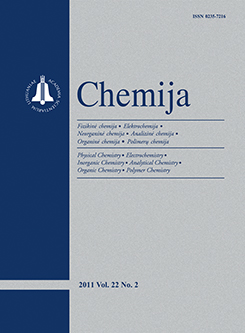Chemija / Chemistry
 ISSN 0235-7216 ISSN 2424-4538 (online) |
2014 m. Nr. 1 Anijoninio dažiklio ir vario(II) šalinimo iš vandeninių tirpalų aktyvintosiomis anglimis efektyvumas: temperatūros ir tirpalo sudėties įtaka
The removal efficiency of anionic metal complex dye Lanasyn Navy M-DNL (LN) and Cu(II) ions has been studied in single and LN dye-Cu(II) binary solutions using the commercial activated carbon. To determine the removal process and properties, the effects of various operating parameters, the initial concentration of Cu(II) ions (1–4 mM), contact time (5–180 min) and temperature (293–333 K) were investigated in a batch adsorption technique. The time profiles for 0.05 mM LN dye and Cu(II) have been obtained using 4.0 g of activated carbon per liter of the solution. The composition of the solution plays an important role in the removal process and the evolution of solution pH. A synergic effect was observed when carrying out the adsorption process at higher temperatures. At the temperatures of 40 and 60 °C the removal percentage of the dye increases by 15–20% in presence of Cu(II) salt. The uptake of Cu(II) also increases by 10% in the presence of LN dye. The adsorbed amount of LN and Cu(II) slightly decreased at 20 °C temperature when the two solutes were present in the solution while the Cu(II) removal almost remained unchanged when Cu(II) concentration was equal to 2 mM. The adsorption process is governed by the pseudo-second-order reaction, at various initial Cu(II) concentrations for the two adsorbates. An increase in temperature leads to an increase in the rate of diffusion of the adsorbed particles into the internal pores of the adsorbent.
Keywords: metal complex dye, copper(II), activated carbon, removal, temperature |
Issues:
2017 - Vol.28 No. 1, No. 2, No. 3, No. 4 2016 - Vol.27 No. 1, No. 2, No. 3, No. 4 2015 - Vol.26 No. 1, No. 2, No. 3, No. 4 2014 - Vol.25 No. 1, No. 2, No. 3, No. 4 2013 - Vol.24 No. 1, No. 2, No. 3, No. 4 2012 - Vol.23 No. 1, No. 2, No. 3, No. 4 2011 - Vol.22 No. 1, No. 2, No. 3, No. 4 2010 - Vol.21 No. 1, No. 2-4 2009 - Vol.20 No. 1, No. 2, No. 3, No. 4 2008 - Vol.19 No. 1, No. 2, No. 3-4 2007 - Vol.18 No. 1, No. 2, No. 3, No. 4 2006 - Vol.17 No. 1, No. 2-3, No. 4 2005 - Vol.16 No. 1, No. 2, No. 3-4 2004 - Vol.15 No. 1, No. 2, No. 3, No. 4 2003 - Vol.14 No. 1, No. 2, No. 3, No. 4 2002 - Vol.13 No. 1, No. 2, No. 3, No. 4 2001 - Vol.12 No. 1, No. 2, No. 3, No. 4 |